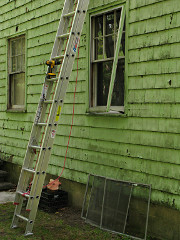
A moment of reflection
| Around this time I had ticked quite a few things off the to-do list, and it was all seeming far less insurmountable than it did a month ago. The weather had been extraordinarily kind in general, making the outdoor work and times with parts of the house unprotected from the elements much easier to deal with. As I mused in email to a friend, it wasn't a roadtrip but definitely a different kind of adventure. A weird mix of elegant solutions, armchair research, and arduous cruft-busting, but all well worthwhile. And possibly worth one or two others' whiles in addition, as I continued trying to send my excess stuff to happy new homes. And I was by no means done doing that yet. |
A storm of windows
Source and sink
|
I posted a complete list
of the windows with dimensions to Craigslist's
"free stuff" area, and ultimately found homes for most of them -- real
homes, e.g. not just letting scrappers haul them off and break them
apart to get a few paltry bucks from recycling the aluminum. When you
get responses of the form "I'll take all of what you're offering" in a
seemingly indiscriminate fashion, that's generally what the taker is
intending to do. Not that it's necessarily bad that some people are
making a little money on the side by hauling stuff to recycling centers,
it just wasn't my ideal intent in this case.
Still, Craigslist was a great resource for turning my trash into someone else's treasure. Efforts to get stuff in general *out* of the house had leveled off a bit by now, but there was still more work to do. There always is. |
More power to him
| As mentioned before, I wanted to try running the new HVAC stuff from a separately energy-metered subpanel to make it easy to collect energy stats for heating and cooling. The power company's meter on the outside of the house had been upgraded to a remote-read type a while back, so I called them trying to find out what they'd done with all the *old* meters. Some surplus house in NY had bought all of them, but their minimum order was sets of four which is how meters generally come boxed for bulk installation. A little research aided by a recommendation from Marc Rosenbaum turned up that good ol' analog, five-pointer clockwork-style electric meters are readily available elsewhere in quantity one, notably from Hialeah Meter down in the Florida town of the same name. For cheap money, too -- like all of sixteen bucks. I ordered one, and a matched socket to put it in. I found out as I went along that just about anyone else doing energy projects and wanting to monitor an electric feed bought from Hialeah too. |
|
I understand a reasonable amount about electricity and electric hardware,
and there's a great profusion of the latter available at the House of
Orange down the road. While I could have muddled my own way through a
panel upgrade it might have involved more low-quality offshore parts
than I'd be comfortable with, I would probably miss a bunch of code
requirements, and it would have taken me forever to figure out and
obtain all the stuff I needed. It wasn't as simple as a panel and a
handful of breakers; the entire feed from the outside needed to be
upgraded and rerouted, and discussions with various electricians held
that 200 amps is pretty much the standard service now. I couldn't see myself
pulling anywhere near that much, but if one considers an electric stove/oven,
dryer, water heater, heat pump, plus all the random lights and plug
loads running at once it could probably add up to well over 100A. And
who knows, if I or a future owner got a crazy idea to put in a hot tub
out back or something... anyway, it would be far easier to pay someone
who routinely handles these jobs to come in and do it to my specs. The
design I had in mind was pretty clear at this point, and even if electrics
was a small part of the overall picture it had to be right.
However, I had no idea electrician-shopping would be such a nightmare. In January I'd talked to a friend from the convention circuit who's an electrician by trade and seemed enthusiastic about tackling my project, saying he did service-entrance and panel upgrades all the time, and then went radio-silent when I tried to follow up and get him in for a site visit. I gave him plenty of chances. The Daikin dealer recommended an electrician he worked with frequently, who was a little hard to reach [teachable moment: professionals should not rely on their teenage daughters to take messages] but he eventually came out for a visit and seemed to understand what I wanted to do and why. Made several promises to hook up with the local inspector and find out about any specific issues. But then he apparently just disappeared -- stopped answering email, never contacted inspectors, never made any moves to schedule work for me. Evidently he left the HVAC guy in the lurch too. After about three weeks of futile "so when do we start?" sort of chasing around, I gave up and started looking around again. Glancing back at some accumulated homeowner-mailing-list traffic turned up a couple of suggestions, and long story a bit shorter I found one who could handle my slightly unusual little job. He was a little skeptical about the metered HVAC side but for the most part understood what I wanted, and suggested handling that part of the job on a time-and-materials basis and obtaining the meter itself would be my problem. But in the meantime we drew up a contract for the base panel and service installation. To finalize the arrangement I went, check in hand, to visit his home-office and sat around with him and his environmental-activist wife and a nice conversation about electrical work, CFL bulbs, sailboats, farmers' markets, hybrid cars, and whatever else. Bottom line, aside from the oil-tank removal guys, real live contractors were *finally* going to start hitting the ground for real here and we had even set a firm start date. He was also a little skeptical about the basement-window blockoff panels which I was insisting be used as service pass-through points, but once I described their construction and showed him a little diagram he agreed that they were a wholly adequate way to avoid interfering with the insulation job. |
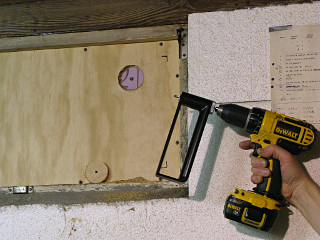
|
I mentioned this to his guys on their first site visit, and on their way
out they left me a 2" PVC pipe fitting so I could determine the exact
size of the hole needed for the *outside* diameter of their conduit.
Turns out that the grey pipe rated for electrical usage is exactly
the same dimensions as the white pipe I already had, so plenty of
references were at hand. Pipe is generally sized by inside diameter, so
my hole had to be about 2-3/8" to fit the outside. With work about to
begin, it was time to get off my butt and go make said hole.
Anticipating the need for making a number of largish openings through the block-offs, I had picked up one of these at the Despot down the road. It's nominally designed for sheet metal but works quite well to just reach through the 3/8" PVC or interior wood layers and cut out circles without ripping into the XPS. Here the tool is missing its pivot piece because with my hole placed so close to the corner of the marked "safe area", obstacles on both sides of the wall presented the same problem but at different points -- after cutting most of the way around there wasn't quite room to swing the back end of the cutter handle full-circle and I had to more or less hand-guide the bit through each small last section. |
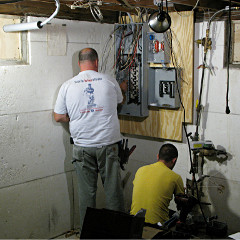
|
With the new panels happily mounted in place, the rest of the inside work
was pretty much plug-n-chug to run all the old circuits [which I'd labeled
under my old numbering system] inside and hook them up. Most of the old
wires were long enough to reach on their own; there were maybe three short
ones that wound up going to a small box up near the sill and then extended
with new Romex to reach.
A slightly different temporary ground attachment was done to the water line, and last thing was to wire a 60A branch over through the meter and into the subpanel underneath. |
| The work lights I had supplied were running on my UPSes for a few hours, one of which was doing the typical APC periodic "beep-beep-beep-beep" alarm thing the entire time. I offered to move over to a different backup unit that didn't do that and turn the noisy one off, but the wire guy was like "nah, I don't mind, it's helping me keep my rhythm!" and later I heard him sort of singing along with it while banging his way through the branch circuits. I was amused. The UPSes held up the whole time without switching sources, which was convenient. | |
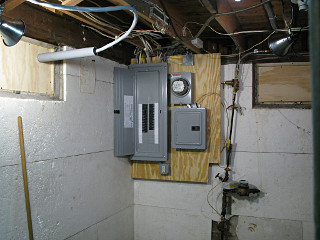
|
The new setup occupies a bit more wall area than the old rig, but there's
plenty of room in the corner for it all without impinging on the plumbing.
Newer code calls for lots of bending space around the connection areas
inside boxes, which is why they're generally larger than the older types
for a given number of branch slots.
Now I wouldn't be able to tell people about having an old 60A fusebox and get to watch them cringe. Interestingly, the GFI convenience outlet they installed below the subpanel failed about a month afterward, got a brief autopsy here, and then get sent off to the manufacturer for analysis. Leviton eventually sent a replacement [which I didn't care about] but never offered the feedback I asked for on the failure. |
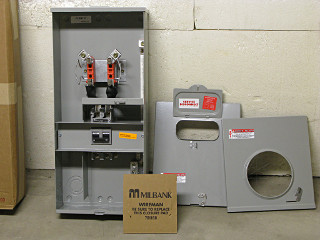
|
They left this monster here, with the intent of eventually mounting it on the outside wall as the official, final meter socket and service entrance. It's another type of NEMA 3R enclosure, which by design and spec isn't 100% weather-tight or insect-tight but can shed and withstand typical falling rain and ice without letting water into internal components. I was a little bothered by the idea of having the main disconnect outside, where someone could conceivably walk up and mess with it, but fortunately these boxes are lockable. This sort of thing is quite standard now, even for a small residential installation. Code wants the main service disconnect as close as possible to the meter, to avoid having long runs of unprotected cable. |
| I hadn't heard of Milbank before, but after looking closely at this and some other gear they make, I'm impressed with their fit and finish by contrast with what else I've seen. Most off-the-shelf electrical hardware is rather klunky and rough, with sharp non-deburred metal edges, cheap plastic standoffs and channels, knockouts that come half knocked-out already, and closures that take a bit of fiddling to close. This feels like generally higher quality. Milbank is supposedly the largest industry maker of meter sockets and associated gear these days, and after learning of their existence I started noticing their stuff attached to the sides of buildings all over the place. Funny how that works. | |
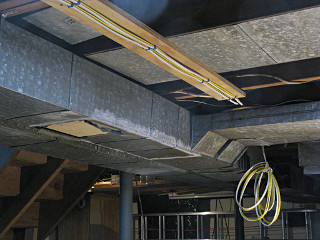
|
A few days later the electricians came back to start running the circuits for the new HVAC stuff. Two runs for the inside air-handler, and two runs to the outside -- a 15 and a 20 apiece. I had to give them the circuiting info, since the HVAC guy didn't bother coordinating with them; it was easy enough to print out a couple of pages from the installation manual (pdf) containing the table showing voltages and "Maximum Overcurrent Protection", e.g. what rating of breaker to put in. Their guy did a nice neat job putting them along the running-board I had mounted to get across all the joist bays. He said the plywood was "perfect" as far as a surface to attach it all to, and the result was exactly as I'd envisioned it when tacking that board up in the first place. |
_H* 120528